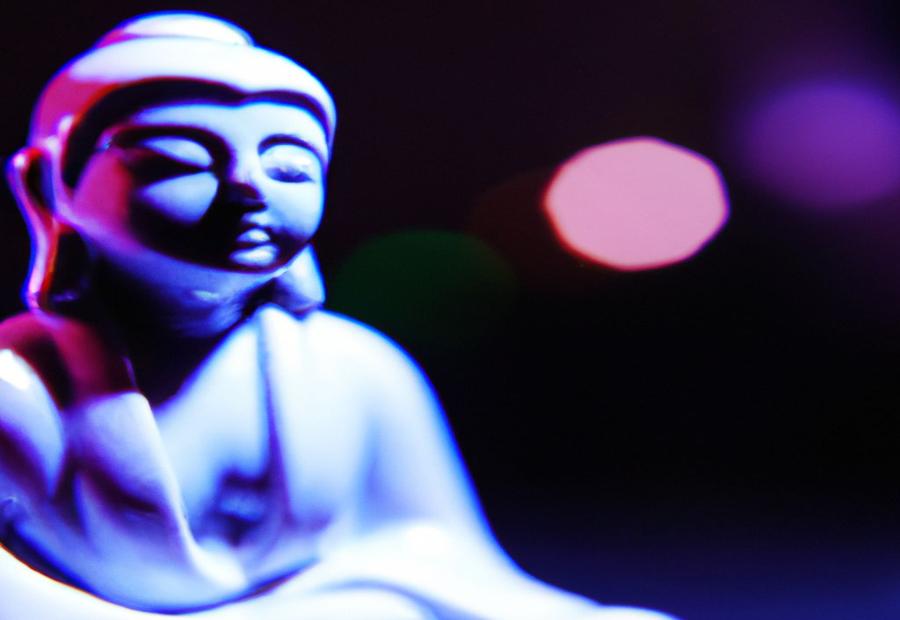Last Updated on July 18, 2023 by Francis
.jpg)
Meditation is a practice that has been hailed for its numerous benefits in promoting relaxation, mindfulness, and overall well-being. One particular form of meditation that has gained attention is Purple Light Meditation.
Purple Light Meditation involves focusing on the color purple and visualizing it as a calming and healing energy. It is a form of visualization meditation that uses the power of the mind to create a serene and tranquil state.
To practice Purple Light Meditation, find a quiet and comfortable space, close your eyes, and begin by taking deep breaths. Imagine a gentle, radiant purple light surrounding you, enveloping your body and mind. As you continue to breathe deeply, allow the purple light to wash away any tension or negative energy, bringing a sense of peace and relaxation.
The benefits of Purple Light Meditation are numerous. It can help reduce stress and anxiety, promote emotional well-being, improve focus and concentration, and enhance overall mental clarity. It can aid in sleep by calming the mind and preparing it for a restful night’s sleep.
While Purple Light Meditation is a unique technique, there are various other meditation techniques available. These include Mindfulness Meditation, Transcendental Meditation, and Loving-Kindness Meditation, each offering its own set of benefits and practices.
Although Purple Light Meditation is generally safe, it is essential to note that everyone may experience meditation differently. Some potential side effects may include feelings of discomfort, increased emotions, or difficulty in concentration. It is always recommended to practice meditation under the guidance of a qualified instructor.
To have a successful meditation practice, it is essential to create a routine and commit to regular practice. Finding a quiet and comfortable space, setting a specific time for meditation, and adopting a non-judgmental attitude are some tips that can help enhance your meditation experience.
Contents
Key takeaway:
- Meditation promotes mental well-being: Meditation is a practice that helps individuals achieve mental clarity and improve overall well-being.
- Purple Light Meditation enhances focus: Purple Light Meditation is a technique that involves focusing on the color purple to deepen concentration and enhance focus during meditation.
- Purple Light Meditation offers various benefits: Practicing Purple Light Meditation can promote relaxation, reduce stress, improve sleep, and increase self-awareness.
What is Meditation?

Photo Credits: Meaning-Of-Number.Com by Bradley Ramirez
Meditation is a practice that involves focusing your mind and redirecting your thoughts. What is Meditation? It is a technique used to achieve a state of mental clarity and calmness. Through meditation, you can relax your body, reduce stress, and improve your overall well-being.
During meditation, it is important to find a quiet and comfortable space. Sit or lie down in a relaxed position, close your eyes, and take deep, slow breaths. Focus your attention on your breath or a specific object or mantra, allowing your mind to be fully present in the present moment.
Meditation is not about eliminating thoughts, but rather observing them without judgment and letting them pass by. It helps to cultivate mindfulness and increase self-awareness. Regular meditation practice has been shown to improve concentration, reduce anxiety, and enhance emotional well-being.
To incorporate meditation into your daily routine, start with short sessions, gradually increasing the duration over time. Find a meditation style that resonates with you, whether it’s guided meditation, mindfulness meditation, or transcendental meditation.
Remember, meditation is a personal journey, and there is no right or wrong way to do it. Experiment with different techniques and discover what works best for you. With consistency and dedication, meditation can be a transformative practice that brings peace and clarity to your life.
+What is Purple Light Meditation?
Purple Light Meditation is a form of meditation that harnesses the power of the color purple to enrich the meditative experience.
This practice entails directing one’s attention towards a glowing purple light source or envisioning oneself surrounded by a radiant purple light.
The color purple has long been associated with spirituality, intuition, and heightened consciousness.
The main objective of this meditation technique is to foster inner tranquility, lucidity, and a profound connection with the spiritual realm.
By incorporating Purple Light Meditation into their daily routine, individuals can further delve into their meditation practice and access their innate wisdom and intuition.
It serves as a potent tool for introspection, relaxation, and personal development.
By infusing the color purple into their meditation sessions, practitioners can elevate their overall well-being and cultivate a stronger sense of inner harmony.
Purple Light Meditation is a universal practice that transcends backgrounds and belief systems, welcoming anyone who seeks to forge a deeper bond with themselves and the spiritual dimensions of existence.
How to Practice Purple Light Meditation?
To practice Purple Light Meditation, follow these steps:
- Find a quiet and comfortable place to sit or lie down.
- Close your eyes and take a few deep breaths to relax your body and mind.
- Visualize a purple light surrounding you, starting from the top of your head and slowly moving down to your toes.
- As you visualize the purple light, focus on its calming and healing properties.
- Imagine the purple light penetrating every cell of your body, cleansing and rejuvenating your entire being.
- Stay in this state of visualization for a few moments, allowing the purple light to fill you with peacefulness and positivity.
- While maintaining the visualization, you can also repeat a positive affirmation or mantra silently in your mind to enhance the effects of the meditation.
- Continue the practice for as long as you feel comfortable, gradually increasing the duration over time.
- When you are ready to end the meditation, slowly bring your awareness back to your surroundings and open your eyes.
Practicing Purple Light Meditation can help promote relaxation, reduce stress, and enhance overall well-being. Remember to choose a time and place where you can fully concentrate and immerse yourself in the meditation experience.
What are the Benefits of Purple Light Meditation?

Photo Credits: Meaning-Of-Number.Com by Alexander Roberts
What are the Benefits of Purple Light Meditation? The benefits of purple light meditation include relaxation, improved focus, and enhanced spiritual connection.
- Relaxation: Purple light meditation can induce a state of relaxation, helping to reduce stress and anxiety. It promotes a sense of calmness and tranquility.
- Improved focus: By allowing the mind to focus on the soothing purple light, meditation can enhance concentration and mental clarity. It helps to quiet the restless thoughts and distractions.
- Enhanced spiritual connection: Purple light is often associated with spirituality and higher consciousness. Engaging in purple light meditation can create a deeper connection with oneself and the universe, fostering a sense of inner peace and harmony.
Engaging in regular purple light meditation can have long-term benefits, such as reducing chronic pain, promoting emotional well-being, and improving overall mental health.
What are the Different Techniques of Meditation?
Curious about the various techniques of meditation? Well, you’re in for a treat! We will be diving into the different ways you can practice meditation, each with its own unique benefits. From the focused awareness of mindfulness meditation to the profound peace of transcendental meditation, and the loving kindness cultivated through loving-kindness meditation, we’ll explore the diverse paths towards inner peace and self-discovery. So, get ready to embark on a transformative journey through the world of meditation!
1. Mindfulness Meditation
Mindfulness meditation is a practice that involves focusing one’s attention on the present moment, without judgment. It is a technique that can be practiced by anyone, regardless of age or background.
During mindfulness meditation, individuals are encouraged to sit in a comfortable position and bring their attention to their breath. They observe their thoughts, feelings, and bodily sensations as they arise, without getting caught up in them or trying to change them. This practice helps to cultivate a state of mindfulness, which is characterized by increased awareness and acceptance of the present moment.
Research has shown that practicing mindfulness meditation regularly can have numerous benefits. It has been found to reduce stress, improve mental clarity and focus, enhance emotional well-being, and promote better sleep. Mindfulness meditation has also been shown to improve relationships and increase empathy and compassion.
To incorporate mindfulness meditation into your daily routine, set aside a few minutes each day for practice. Find a quiet and comfortable space, set a timer, and simply focus on your breath. Allow yourself to notice any thoughts or distractions that arise, and gently bring your attention back to the breath. Over time, you can gradually increase the duration of your practice.
Mindfulness meditation has its roots in ancient Buddhist traditions, where it has been practiced for thousands of years. In recent decades, mindfulness meditation has gained widespread popularity and recognition in the Western world, thanks in part to scientific research demonstrating its benefits. Today, it is commonly used in various settings, including schools, workplaces, and healthcare settings, as a tool for promoting well-being and reducing stress.
2. Transcendental Meditation
Transcendental Meditation is a meditation technique that involves the use of a mantra, a specific sound or word, to help the mind settle into a state of deep relaxation and inner peace. It is practiced for about 20 minutes, twice a day, sitting comfortably with eyes closed. Unlike other forms of meditation, Transcendental Meditation does not involve concentration or controlling thoughts. Instead, it allows the mind to effortlessly transcend normal thinking and access a state of pure awareness.
During Transcendental Meditation, the mind settles into a state of deep rest where the body experiences a state of relaxation similar to sleep, but with heightened awareness. This practice has been shown to have numerous benefits, including reduced stress, improved focus and concentration, increased creativity, and improved overall well-being.
Transcendental Meditation has been widely studied and has been found to provide a number of positive effects on mental and physical health. Research has shown that it can reduce symptoms of anxiety and depression, lower blood pressure, improve sleep, and even boost cognitive function.
If you’re interested in practicing Transcendental Meditation, it’s recommended to learn from a qualified teacher who can guide you through the process and provide personalized instruction. By incorporating Transcendental Meditation into your daily routine, you can experience the profound benefits it offers for your mind, body, and overall well-being.
3. Loving-Kindness Meditation
-
Loving-Kindness Meditation is a powerful practice that focuses on cultivating love, compassion, and kindness towards oneself and others.
-
To engage in Loving-Kindness Meditation, it is important to find a serene and comfortable space where you can either sit or lie down.
-
Initiate the practice by taking a few deep breaths in order to foster relaxation within your body and mind.
-
Concentrate on sending heartfelt and benevolent thoughts to yourself. Reiterate phrases such as “May I be happy. May I be healthy. May I be safe. May I live with ease.”
-
Subsequently, shift your attention towards someone dear to your heart, like a loved one or a close friend. Echo the same phrases, directing them towards that individual.
-
Continue to broaden your circle of compassion by extending loving-kindness towards neutral individuals, strangers, and even challenging people in your life.
-
While repeating the phrases, visualize the person or people you are sending loving-kindness to, and imagine them bathed in a comforting, radiant light.
-
Spend a few minutes with each person before proceeding to the next.
-
Conclude the practice by projecting loving-kindness to all beings in the world, desiring their happiness and well-being.
Can Purple Light Meditation Help with Sleep?
Purple light meditation has been proven to be beneficial for sleep. It is a form of meditation that encourages relaxation and reduces stress levels, which are common factors that disrupt sleep.
Numerous studies have demonstrated that engaging in purple light meditation for only 10 minutes before going to bed can considerably enhance the quality of sleep. In fact, research has indicated that this practice can increase the amount of deep sleep and lessen the number of awakenings throughout the night, leading to a more restful and rejuvenating sleep experience.
Moreover, purple light meditation is known to stimulate the production of melatonin, the hormone responsible for regulating sleep-wake cycles. By incorporating this practice into your nighttime routine, you can cultivate a serene and tranquil environment that promotes improved sleep.
So, if you struggle with sleep issues, why not give purple light meditation a try and witness the positive effects it can have on your sleep quality.
What are the Potential Side Effects of Purple Light Meditation?

Photo Credits: Meaning-Of-Number.Com by Bruce Davis
What are the Potential Side Effects of Purple Light Meditation?
- Potential Eye Strain: Staring at a bright light for extended periods of time, such as purple light during meditation, can cause eye strain and discomfort.
- Disruption of Sleep Patterns: Exposure to purple light close to bedtime can interfere with the body’s production of melatonin, a hormone that regulates sleep, potentially leading to difficulty falling asleep or disrupted sleep patterns.
- Headaches and Migraines: Some individuals may be sensitive to bright lights, and exposure to purple light during meditation may trigger headaches or migraines in susceptible individuals.
- Increased Sensitivity to Light: Prolonged exposure to purple light can result in increased sensitivity to light, making it uncomfortable to be in bright environments even after meditation.
- Distracted Focus: For some individuals, the presence of vibrant purple light during meditation may be distracting and make it challenging to achieve a deep state of relaxation and focus.
- Photosensitivity Reactions: Certain individuals may experience photosensitivity reactions, such as rashes or skin irritation, when exposed to intense purple light during meditation.
- Potential Interference with Medications: Purple light therapy or exposure may interact with certain medications, so it is important to consult a healthcare professional before incorporating purple light meditation into a healthcare regimen, especially for individuals taking photosensitizing medications.
What are Some Tips for Successful Meditation Practice?

Photo Credits: Meaning-Of-Number.Com by Jack Jones
What are Some Tips for Successful Meditation Practice?
- One of the important tips for successful meditation practice is to find a quiet and comfortable space.
- To promote alertness and focus, it is recommended to sit in a relaxed and upright posture.
- Start your meditation session by taking a few deep breaths to calm the mind and body.
- To anchor your awareness, you can choose to focus on your breath or a specific object.
- When thoughts arise during meditation, it’s important to gently acknowledge them without judgment and let them pass.
- If your mind wanders, bring your focus back to your breath or chosen anchor.
- In the beginning, start with shorter meditation sessions and gradually increase the duration over time.
- To maximize the benefits, it is advised to establish a regular meditation routine and be consistent.
- During the meditation process, it is normal to have thoughts and distractions, so it’s important to practice self-compassion and patience.
Some Facts About “MediTaTioN PuRPLe LigHT”:
- ✅ Seeing purple during meditation is a common experience reported by many individuals. (Source: selfdevelopmentjourney.com)
- ✅ Purple is associated with the crown chakra, representing spiritual awareness and higher consciousness. (Source: yogic-experience.com)
- ✅ The color purple during meditation is linked to inner imagination and mental harmony. (Source: yogic-experience.com)
- ✅ Purple light in meditation may indicate a blocked or conflicting crown chakra. (Source: foryourmassageneeds.com)
- ✅ Incorporating purple light in meditation can help address imbalances in life and promote spiritual growth. (Source: foryourmassageneeds.com)
Frequently Asked Questions
What does it mean if I see purple during meditation?
Seeing purple during meditation may indicate an imbalance or issue with the crown chakra. The crown chakra, represented by the color purple, is important for spiritual awareness and connecting with a higher state of consciousness.
What are the meanings of other colors that may be seen during meditation?
Colors seen during meditation often relate to the seven chakra points in the body. Each chakra represents a different focal point and is associated with a specific color. For example, green represents the heart chakra and is associated with compassion and inner serenity. Red is linked to the root chakra and helps to keep us grounded.
How can I unlock and balance my crown chakra?
To unlock the crown chakra during meditation, you can practice specific techniques such as focusing on the crown chakra and picturing a lotus on the forehead. Making the meditation space comfortable and using meditation techniques can also help unlock the crown chakra.
Can seeing colors during meditation have negative impacts?
Chakra imbalances can have negative impacts on spiritual, mental, and physical well-being. Therefore, it is important to evaluate the colors and visions seen during meditation in order to address any chakra imbalances.
Are there any potential benefits to seeing purple during meditation?
Seeing purple during meditation can indicate progress in unlocking the crown chakra and may signify spiritual growth and a deeper connection with a higher state of consciousness.
How can I incorporate the colors I see during meditation into my practice?
You can incorporate the colors you see during meditation into your practice by focusing on each chakra and its associated color. By meditating on a particular color, you can address mental or physical issues related to that color. You can also direct the colors to different parts of your body and invoke healing through the colors.





